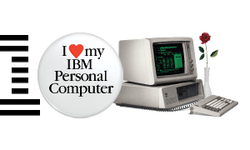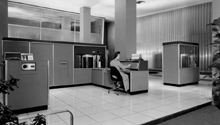16th June - the start of IBM's 101th year
A short article that identifies the lessons learned over the past 100 years.
| ibm_centennial.pdf | |
| File Size: | 1433 kb |
| File Type: | |
IBM Centennial Year
You know, sometimes it is just a good feeling to say that you are proud of the work you do. In this case. I am going to be unashamedly proud of the organisation in which I work. Therefore, for those who are interested keep coming back to visit this page as I display the weekly descriptions of how IBM has changed the world over the last century.
In the span of a century, IBM has evolved from a small business that made scales, time clocks and tabulating machines to a globally integrated enterprise with 400,000 employees and a strong vision for the future. The stories that have emerged throughout our history are complex tales of big risks, lessons learned and discoveries that have transformed the way we work and live. These 100 iconic moments—these Icons of Progress—demonstrate our faith in science, our pursuit of knowledge and our belief that together we can make the world work better.
In the span of a century, IBM has evolved from a small business that made scales, time clocks and tabulating machines to a globally integrated enterprise with 400,000 employees and a strong vision for the future. The stories that have emerged throughout our history are complex tales of big risks, lessons learned and discoveries that have transformed the way we work and live. These 100 iconic moments—these Icons of Progress—demonstrate our faith in science, our pursuit of knowledge and our belief that together we can make the world work better.
Petaflop (1,000 trillion operations per second)
Next time you have 30 minutes to spare, come here and watch a very interesting account of how many things we take for granted have started in IBM labs. I am afraid it gets a bit like propaganda towards the end, but please enjoy.
The first electronic calculator
The first electronic calculator ever placed into production, the IBM 603, was the first commercial product to incorporate electronic arithmetic circuits. This marked a major shift for IBM, from mechanical to electronic computation. Born from the company’s continuing focus on electronic development, the 603 was part of a program to make an electronic “super calculator” that would perform calculations faster than 1944’s ASCC, a 51-foot-long machine. The result was a considerably smaller device that used vacuum tubes to perform multiplication far more rapidly than earlier electromechanical devices. For the first time, calculations could be done instantaneously. This was in September 1946.
Tracking infectious diseases
In 1976, the World Health Organization utilized the IBM System/370 at the United Nations’ International Computing Center in Geneva to precisely map trends and outbreaks of smallpox so that it could best allocate its limited personnel and resources to the most urgent locations. The system became a global model for demographic tracking. Since then, IBM has worked to understand the spread of many epidemics and pandemics. It partnered with the Centers for Disease Control to model the spread of H1N1—the “swine flu”—and developed the Spatiotemporal Epidemiological Modeler for use in tracking bird flu, dengue fever, and other infectious diseases that threaten human wellbeing.
Innovation before the computer

The IBM ® Selectric typewriter was a radical innovation that completely disrupted the business typewriter market. It transformed the speed, accuracy and flexibility with which people could generate the written word, and helped pave the way for the use of typewriter keyboards as the primary method for humans to interact with computers.
The golf ball typing element was designed by an engineering team led by Horace “Bud” Beattie. The team members, according to a 1961 advertisement for the Selectric, “began their search by forgetting the past fifty years of typewriter design.” The first type head design had been shaped more like a mushroom, but under Beattie’s direction, IBM engineer John Hickerson revised the type head toward its ultimate spherical configuration.
The golf ball typing element was designed by an engineering team led by Horace “Bud” Beattie. The team members, according to a 1961 advertisement for the Selectric, “began their search by forgetting the past fifty years of typewriter design.” The first type head design had been shaped more like a mushroom, but under Beattie’s direction, IBM engineer John Hickerson revised the type head toward its ultimate spherical configuration.
Personal computing comes of age

On August 12, 1981, at a press conference at the Waldorf Astoria ballroom in New York City, Phillip “Don” Estridge announced the IBM Personal Computer (IBM 5150) with a price tag of $1,565. Two decades earlier, an IBM computer often cost as much as nine million dollars and required an air-conditioned quarter-acre of space with a staff of 60. The new IBM PC was not only faster, it put a computer within every household’s reach.
Revolutionising the Airline ticketing system
This all started because of a chance meeting in 1953. A young IBM salesman, R. Blair Smith, had boarded an American flight from Los Angeles to New York on his way to a training session. He got into a conversation with the man sitting next to him, who turned out to be C.R. Smith, the president of American Airlines. At the time, airline reservations were written by hand on cards and sorted in boxes—an unwieldy mess as the industry expanded. Blair Smith knew that American had an older model computer that could only keep track of the number of seats reserved and open on a flight, but could not record anything about who was in those seats.
As Blair Smith recalled: “I told [C.R. Smith] I was going back to study a computer that had the possibility of doing more than just keeping availability. It could even keep a record of the passenger’s name, the passenger’s itinerary, and, if you like, his phone number. Mr. C.R. Smith was intrigued by this. He took out a card and wrote a special phone number on the back. He said, ‘Now, Blair, … when you get through with your school, our reservation center is at LaGuardia Airport. You go out there and look it over. Then you write me a letter and tell me what we ought to do.’”
As Blair Smith recalled: “I told [C.R. Smith] I was going back to study a computer that had the possibility of doing more than just keeping availability. It could even keep a record of the passenger’s name, the passenger’s itinerary, and, if you like, his phone number. Mr. C.R. Smith was intrigued by this. He took out a card and wrote a special phone number on the back. He said, ‘Now, Blair, … when you get through with your school, our reservation center is at LaGuardia Airport. You go out there and look it over. Then you write me a letter and tell me what we ought to do.’”
Revolutionising Railways

In 1896, the New York Central & Hudson River Railroad became one of the first commercial users of the tabulating equipment invented by Herman Hollerith’s Tabulating Machine Company, a predecessor of IBM, to keep track of operations. It revolutionized the railroad’s ability to keep up with increasing volumes of data—especially statistics relating to freight traffic.
IBM’s first customer in Italy, the Italian state-owned Ferrovie dello Stato (Italian Railways) turned to IBM in 1928 to automate its administrative processes. The result was an inventory of spare parts that drastically reduced waste and statistical traffic analysis that helped to schedule and allocate trains.
IBM’s first customer in Italy, the Italian state-owned Ferrovie dello Stato (Italian Railways) turned to IBM in 1928 to automate its administrative processes. The result was an inventory of spare parts that drastically reduced waste and statistical traffic analysis that helped to schedule and allocate trains.
A Computer Called Watson
IBM’s latest supercomputer, code-named “Watson” leverages the leading edge Question-Answering technology, allowing the computer to process and understand natural language. It incorporates massively parallel analytical capabilities to emulate the human mind’s ability to understand the actual meaning behind words, distinguish between relevant and irrelevant content, and ultimately, demonstrate confidence to deliver precise final answers. On 14th - 16th February 2011, Watson will make history by being the first computer to compete against humans on television’s venerable quiz show, Jeopardy.
Rise of the Internet
IBM has always been a forerunner of using technology to share and connect information. In 1987, the US National Science Foundation selected IBM and two other companies to develop a high-speed network called NSFNET that connected 200 American universities to six American supercomputer centers. IBM was central to this effort, developing new technologies, linking existing hardware and software to the network, and finding new ways to help create what was growing into the nation’s information backbone. The success of NSFNET’s transition from private to commercial use served as a blueprint for the modern Internet.
Equipment and parts flowed in from IBM and other companies, such as computers and peripheral gear, which they configured and tested then deployed to various campuses and super computer sites. "We turned the third floor of the Computer Center into an assembly line.… In the end we had the whole floor covered with parts and machines and boxes; it was a great way to deploy everything," remembers Elise Gerich who was the site liaison at the time. In fact, 150 systems with thousands of machines, parts and telco equipment from Cisco and MCI were implemented. Eight months later, in July 1988, the network went live with 170 networks linked together, making it possible for the first time for the academic and research communities to access a high-speed, reliable and effective data network service that spanned the United States. The previous network, ARAPANET, was shut down soon after, since the new one worked so well.
Equipment and parts flowed in from IBM and other companies, such as computers and peripheral gear, which they configured and tested then deployed to various campuses and super computer sites. "We turned the third floor of the Computer Center into an assembly line.… In the end we had the whole floor covered with parts and machines and boxes; it was a great way to deploy everything," remembers Elise Gerich who was the site liaison at the time. In fact, 150 systems with thousands of machines, parts and telco equipment from Cisco and MCI were implemented. Eight months later, in July 1988, the network went live with 170 networks linked together, making it possible for the first time for the academic and research communities to access a high-speed, reliable and effective data network service that spanned the United States. The previous network, ARAPANET, was shut down soon after, since the new one worked so well.
1st magnetic hard disk
The world’s first hard disk drive was the size of two kitchen refrigerators set side by side. It contained 24 disks spinning at 1,200 revolutions per minute, supplying data at 100,000 bits per second. It was the IBM RAMAC (Random Access Method of Accounting and Control), and it allowed enterprises to think about data in new ways—mixing and matching it on the fly, allowing each bit of information to be read or changed randomly. Along with IBM’s magnetic tape drive, the 1956 release of RAMAC essentially launched the data storage industry.
n 1952, with computer excitement in the air, IBM sent Reynold Johnson to San Jose to start a new research lab. When the Air Force wanted a random access inventory system, Johnson set his 50-person lab in motion, trying everything—strips, rods, tapes, flat plates, you name it. In the early 1950s, no one had any idea how to make a fast, reliable random access memory machine.
n 1952, with computer excitement in the air, IBM sent Reynold Johnson to San Jose to start a new research lab. When the Air Force wanted a random access inventory system, Johnson set his 50-person lab in motion, trying everything—strips, rods, tapes, flat plates, you name it. In the early 1950s, no one had any idea how to make a fast, reliable random access memory machine.
Laser Eye surgery

“IBM” on a strand of hair.
Here, the excimer laser is used to demonstrate precision and scale, etching “IBM” onto a strand of human hair.
Here, the excimer laser is used to demonstrate precision and scale, etching “IBM” onto a strand of human hair.
In 1981, three IBM scientists—Rangaswamy Srinivasan, James Wynne and Samuel Blum—discovered how the newly invented excimer laser could remove specific human tissue without harming the surrounding area and do so on an extremely minute scale—a process that became the foundation for LASIK and PRK surgery. The painless procedure, which changes the shape of the cornea, has improved the vision and quality of life for millions of people around the world.
Magnetic stripe
In 1969, IBM engineer Forrest Parry had a problem. He was trying to affix a strip of magnetized tape with a piece of plastic to create an identity card for the CIA, but he was struggling to combine the two components. When he mentioned the problem to his wife, who happened to be ironing clothing at the time, she suggested that he use the iron to melt the strip on. He tried it, and it worked. The magnetic stripe, when combined with point-of-sale devices and data networks, was one of the catalysts that accelerated the proliferation of credit card usage around the world, transforming commerce forever.
Working with the banking and airlines industries, IBM helped develop the approach that was adopted as a U.S. standard in 1969 and an international standard two years later. That meant that anybody could use their magnetic stripe credit or debit card anywhere in the world. It also meant that IBM couldn’t benefit directly from its magnetic stripe inventions. “We decided not to patent the stripe or the stripe production technologies. We wanted everybody to use them,” says Jerome Svigals, IBM’s magnetic stripe project manager in the 1960s and early ‘70s. But IBM was compensated, just the same. “For every buck we spent on developing the mag stripe, we got [US]$1500 back in computer sales,” Svigals says. “Our motive was to drive computer sales, and we did.”
Working with the banking and airlines industries, IBM helped develop the approach that was adopted as a U.S. standard in 1969 and an international standard two years later. That meant that anybody could use their magnetic stripe credit or debit card anywhere in the world. It also meant that IBM couldn’t benefit directly from its magnetic stripe inventions. “We decided not to patent the stripe or the stripe production technologies. We wanted everybody to use them,” says Jerome Svigals, IBM’s magnetic stripe project manager in the 1960s and early ‘70s. But IBM was compensated, just the same. “For every buck we spent on developing the mag stripe, we got [US]$1500 back in computer sales,” Svigals says. “Our motive was to drive computer sales, and we did.”
Patents and Innovation

By hiring engineer and inventor James W. Bryce in 1917, Thomas Watson Sr. showed his commitment to pure inventing. Bryce and his team established IBM as a long-term leader in the development and protection of intellectual property. By 1929, 90 percent of IBM's products were the result of Watson's investments in R&D. In 1940, the team invented a method for adding and subtracting using vacuum tubes—a basic building block of the fully electronic computers that transformed business in the1950s. This pattern—using innovation to create intellectual property—shaped IBM's history.
Leader in Patents

IBM has a longstanding history of patent leadership. In 2010, the company was awarded 5,896 patents, exceeding the combined issuances of Microsoft, Hewlett-Packard, Oracle, EMC and Google.
The Floppy disk

The IBM engineers who developed the floppy disk never could have dreamed that it would soon become instilled in the fabric of consumers' lives. It was originally designed for large-scale systems, as a more efficient form factor for IBM's System/370 mainframe data loads. But soon, the disk's small size and ever-increasing storage capabilities led to its adoption by smaller systems as well. Usable, durable and flexible, the floppy disk quickly became ubiquitous as the preferred storage medium for the emerging personal computer industry.
Today, the disks can be found mainly in the dusty bottoms of desk drawers and filing cabinets. Yet the floppy disk will go down as a singular advance in computing history. Floppies helped enable the PC revolution and the emergence of an independent software industry that now includes more than 10,000 companies. “It turned out to be one of the most influential product introductions ever in the industry,” says Jim Porter, a long-time disk drive analyst.
Today, the disks can be found mainly in the dusty bottoms of desk drawers and filing cabinets. Yet the floppy disk will go down as a singular advance in computing history. Floppies helped enable the PC revolution and the emergence of an independent software industry that now includes more than 10,000 companies. “It turned out to be one of the most influential product introductions ever in the industry,” says Jim Porter, a long-time disk drive analyst.

